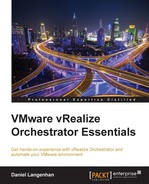As discussed in the first chapter with regard to the Orchestrator architecture, Orchestrator uses a plugin infrastructure to expend its possibility. We also said in the last chapter that plugins have to be installed at the moment (at the time of writing this book) by using the vRealize Orchestrator Configuration, as the Control Center isn't ready to perform this operation yet.
There are many plug-ins for Orchestrator. Check Chapter 1, Architectural Overview, for an overview and links to the web pages where you can get them. In this chapter, I will install the VMware NSX (also called vCNS) plug-in. The method used is the same for all the other plug-ins that exist. Feel free to download and install a different plug-in.
- Open a web browser and visit www.vmware.com.
- Click on Downloads.
- Search for VMware vSphere and click on Drivers & Tools.
- Expand VMware vRealize Orchestrator Plugin.
- Select Go to downloads next to the plug-in that you would like to download.
- Enter your VMware credentials and proceed to download.
- The file that you are downloading has the
.vmoappending.
If you would like to download any other plug-in, have a look at the More about plug-ins section of the first chapter.
Now that we have downloaded the plug-in, we should install it in Orchestrator. As already mentioned, we will have to use the Orchestrator Configuration. If you are using a newer version (I am using version 6.0.2), check out the Control Center to check whether the plug-in install works.
We will now open the Orchestrator configuration and check for all the installed plug-ins:
- Open a web browser and open the Orchestrator home page by entering the FQDN or IP of your Orchestrator, as shown in Chapter 2, Deploying and Configuring the Orchestrator Appliance.
- From the Orchestrator home page, select the link to the Orchestrator Configuration.
- A second web page opens up and asks you to log in. Use
vmwareas the username, and use the password that you assigned during the deployment. - Click on Plug-ins. This page shows you all the plug-ins that are already installed. Have a look:

If you uncheck the tick box in front of a plug-in, you can disable it. There isn't really a method as such to uninstall a plugin. If you install a newer version of a plugin, the old version will be overwritten. However, you cannot replace a newer version with an older version so easily.
Let's install a new plug-in in Orchestrator:
- In the Orchestrator Configuration, click on General.
- Select Install Application.
- Click on the magnifying glass icon. Now, select the plug-in file that you would like to install.
- Click on Install.

- Accept the EULA by clicking on I accept the terms of the License Agreement.

- If the plug-in has installed successfully, you should see a green message at the top of the window. Also, you can check the Plug-ins tab.

We have installed the plug-in. However, to make it work, we need to restart the Orchestrator service.
After you have installed a plug-in, you need to restart the Orchestrator service. You can do this in two ways. The first is to restart the Orchestrator VM. This is a bit drastic and takes longer time. However, it also works. The easier and smarter way is to just restart the Orchestrator service.
- In the Orchestrator Configuration, click on Startup Options.
- Then, click on Restart service.
- After the server has restarted, you should see a green message that tells you that the restart process has successfully finished.

After installing the plug-in, we should have a look what it provides us with. Each plug-in comes with predefined workflows and actions. Let's have a look at the pre-defined workflows:
- Open the Orchestrator client and log in as a user of the Orchestrator Admin group.
- Go to the workflow library and expand it. Look for the plug-in. As I chose to install the VMware NSX plug-in, I look for NSX.
- Expand the subfolders and browse around. Have a look at what is there.

Most plug-ins come with a Configuration folder that contains workflows to bind Orchestrator to a specific instance of the plug-in; in my case, an NSX endpoint.
If you haven't heard about VMware NSX, it is a network virtualization tool that allows you to create isolated networks, routers, NATs, gateways, load balancers, and VPNs, without the need to have additional hardware.
It happens from time to time that, after you install a plugin, and you check the Orchestrator client, you cannot find any additional workflows or actions. If this is the case, you need to run the workflow Library | Configuration | Troubleshooting | Reinstall the plug-ins when the sever starts. We have used this in the last step in Chapter 2, Deploying and Configuring the Orchestrator Appliance. After running this workflow, restart either the Orchestrator service or the whole appliance.
